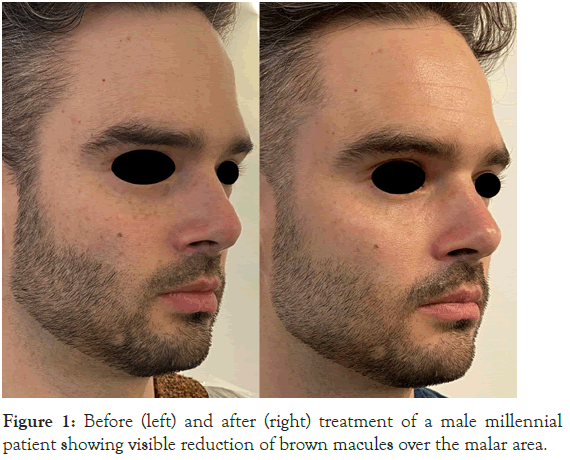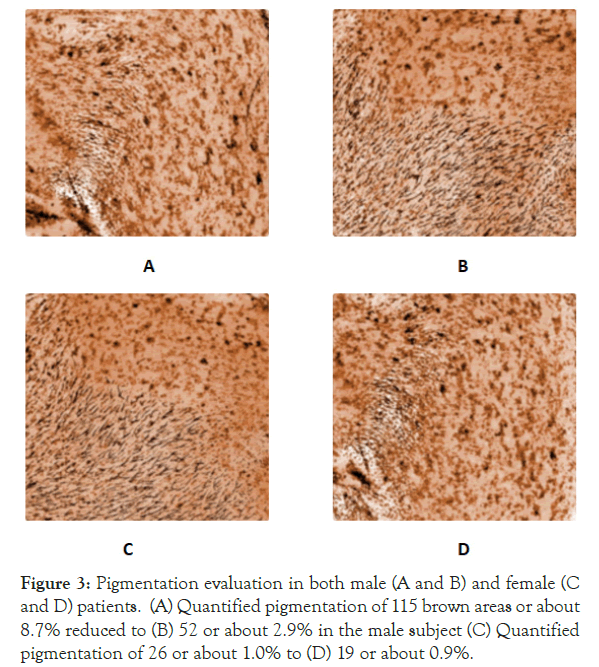Journal of Clinical & Experimental Dermatology Research
Open Access
ISSN: 2155-9554
+44 1478 350008
ISSN: 2155-9554
+44 1478 350008
Case Report - (2021)
Background: Millennials represent a growing segment of the population that requires aesthetic treatments. Commonly, these individuals seek to undergo minimally invasive procedures to achieve ‘prejuvenation’ in order to delay the signs of aging because these procedures offer good aesthetic outcomes without the downtime and cost associated with more invasive options.
Objective: Agents used for resurfacing, skin tone correction, and biorevitalising have been shown individually to address skin quality, melanogenesis, and rejuvenation, respectively. In this case report, the aim was to evaluate the overall prejuvenation effects of the combination of these agents in millennial subjects.
Case description: Two patients with hyperpigmentation were evaluated prior to and after the prescribed regimen. Apparent improvements in skin quality and tone were documented after treatment.
Conclusion: The combination of agents for prejuvenation was found to improve the overall quality of the skin and objectively reduced hypermelanosis in both male and female subjects.
Depigmentation; Hypermelanosis; Multi-modal; Millennial; Prejuvenation; Hydrobooster
Millennials, or individuals born between 1981 and 1996, are fast becoming an important and significant segment of patients seeking elective aesthetic interventions. A unique attribute of this group is their widespread exposure to social media and digital influencer culture, which has a deep fixation on image consciousness [1]. As a result of this pressure, many millennials would like to achieve an aspirational version of themselves and consequently, seek cosmetic treatment for structural imperfections of the face. Often, they undergo minimally invasive procedures to achieve ‘prejuvenation’ a term coined to define the prevention of aging through the process of rejuvenation – that is, treatment used to delay the signs of aging [2]. These procedures, indeed, allow them to achieve good aesthetic outcomes with the advantages of short recovery times and relative affordability of the products and procedures [2].
Prejuvenation is often sought as preventative treatment by millennials and is believed to address the early onset of aesthetic concerns that otherwise do not normally manifest in younger patients. Services requested may range from skin resurfacing for treatment of sunspots and wrinkles, to neuromodulation for dynamic wrinkles and volume and ptosis correction with soft tissue fillers. Among the most common of aesthetic concerns in millennials is hypermelanosis or hyperpigmentation. This condition can be acquired after skin injuries or cutaneous inflammation, the use of certain medications, hormones, as well as inflammatory skin diseases such as acne [3]. Regardless of the causes and extent, hypermelanosis can have a major psychosocial impact on patient’s quality of life and bring about emotional and psychological distress. Millennials with facial hypermelanosis resort to using maquillage or heavy make-up to conceal imperfections. Fortunately, a number of treatment options are available with most of them being minimally invasive cosmetic procedures.
Treatment for hypermelanosis can be thought to belong to distinct categories based on the depth of treatment: (1) topical depigmenting agents, (2) chemical peels, and (3) laser and light-based therapy. Others considered to belong in the same group, but are less likely to have lasting and deep effects, include the use of photoprotective agents and cosmetic camouflage [3]. Most cosmetic agents and topical depigmenting products have been incorporated in over-thecounter products, while more invasive options are available in the clinic setting.
Multi-agent topical depigmenting regimens are common and have been found to have several advantages over single agents. Often, pre- and post-treatment solutions are introduced along with the main peeling agent to enhance its clinical properties and prevent complications [4,5]. These depigmenting agents may contain superficial peeling chemicals, i.e., 20% to 40% salicylic acid and/ or 50% pyruvic acid, at times combined with retinoids, i.e., 0.25% retinoic acid, which are thought to have synergistic keratolytic action on the superficial layers of the skin [6-8]. An example of a recently developed depigmenting suite of peeling agents is the DefinisseTM Peel Program, a three-step regimen composed of (1) pre-peeling, (2) classic chemical peeling and post-peeling lightening, and (3) neutralising agents. In general, the classic peel (composed of <25% salicylic acid, <10% pyruvic acid, <0.05% retinoic acid) can be used to address photo-aging, superficial wrinkles, post-acne skin imperfections, superficial scars and seborrhoeic skin [5]. The lightening product, which is a formulation with <5% N-undecyl-10- enoyl-L-phenylalanine (Sepiwhite), N-undecylenoyl phenylalanine, an alpha-Melanocyte-Stimulating Hormone (MSH) receptor antagonist clinically proven to reduce hyperpigmentation after 8 weeks [9], in combination with <5% diacetyl boldine and the same classic concentration of salicylic acid, pyruvic acid, trans-retinoic acid, addresses uneven pigmentation.
The Pigment SolutionTM Program is a topical treatment regimen that has been evaluated as a first-line treatment option to reduce hyperpigmentation and to achieve an even skin tone in disorders such as melasma [10]. The program comprises three products, namely the Pigment SolutionTM preparation cleanser, the Pigment SolutionTM day cream and the Pigment SolutionTM night cream, all of which have been formulated for regular daily use. Of these, the day cream and the night cream mainly have lightening effects. The former contains vitamin A and E and 0.3% kojic acid in combination with humectants and hygroscopic compounds to stimulate cell renewal, reduce pigmentation and maintain hydration, while the latter evens out pigmentation through the peeling action of 5.7% glycolic acid and 0.3% kojic acid [10,11].
One other tool that has recently gained traction and is now used by many aesthetic medicine practitioners is mesotherapy. This is used to correct or halt age-related changes in skin related to atrophy, loss of skin elasticity and decreased hydration that come as a result of lower HA levels [12,13]. Mesotherapy agents promote skin restoration and prejuvenation through maintaining extracellular matrix molecules and water in skin [14]. DefinisseTM hydrobooster combines the established clinical benefits of hyaluronic acid (HA, 18 mg/mL) and glycerol (20 mg/mL) and is used to improve skin hydration, skin tone, and elasticity while being injected in the superficial dermis [15]. The clinical benefit of HA is well established-it reduces the early signs of aging by improving skin brightness, texture and turgor [16]. Glycerol, on the other hand, works as a strong moisturising agent and plays a role in improving skin elasticity by enhancing the action of HA [17]. The product comes with TerumoTM needles (CE 0197, 2 x 30G ½" thin wall) that facilitate injections with low extrusion force.
I present two cases where I evaluated the effect of the combination of the DefinisseTM lightening peel, Pigment SolutionTM Program and DefinisseTM hydrobooster – or the RESURFACE, RETONE and REBOOST approach – on melanogenesis, skin quality, and ultimately, satisfactory prejuvenation outcomes in millennial subjects.
Two millennial subjects, one female and one male, who have active lifestyles with constant sun exposure were included in this evaluation. Treatment for both patients followed the same regimen:
• Day 1: DefinisseTM lightening peel treatment
• Day 5: Pigment SolutionTM Program
• Day 9: DefinisseTM hydrobooster
• Day 14: DefinisseTM lightening peel treatment
This sequence was specially designed to test the hypothesis that prejuvenation can be better achieved by firstly ‘resurfacing’ the skin to enhance the penetration of topical treatment, where active ingredients could improve skin tone or ‘retone’ the skin. This is then followed by skin hydrobooster injections to increase skin hydration and elasticity or ‘reboost’ the skin. Upon explanation of the procedures, the patients were asked to sign informed consent forms. Pictures were then taken before and after treatment with LifeViz Mini 3D camera by Quantificare. Any significant pigmentation were evaluated before and after treatment.
Baseline evaluation of the two subjects revealed that the male subject had ephelides over the temporal and malar areas, while the female subject had a few hyperpigmented macules found all over the face compatible with solar lentigines. Comparing the pictures of both subjects before (Figures 1A and 2A) and after (Figures 1B and 2B) the treatments, it can be observed that the combination of resurfacing by chemical peeling using DefinisseTM lightening peel, retoning with topical hyperpigmentation treatment using Pigment SolutionTM Program, and reboosting with injectable biorevitalising mesotherapy using DefinisseTM hydrobooster, resulted in an improvement in skin quality, skin tone, as well as a reduction in hyperpigmentation. A clear reduction in pigment count was also observed in both cases, as shown in Figure 3.

Figure 1: Before (left) and after (right) treatment of a male millennial patient showing visible reduction of brown macules over the malar area.

Figure 2: Before (left) and after (right) treatment of a female millennial patient showing slight reduction of brown macules over the forehead, temporal and malar areas.

Figure 3: Pigmentation evaluation in both male (A and B) and female (C and D) patients. (A) Quantified pigmentation of 115 brown areas or about 8.7% reduced to (B) 52 or about 2.9% in the male subject (C) Quantified pigmentation of 26 or about 1.0% to (D) 19 or about 0.9%.
After treatment, I advised the patients to lightly dab the face with cold compress to remove any lingering stinging sensation. I then instruct them to use a bland moisturizer and physical blocker sunscreen after washing with a gentle non-detergent cleanser. For the purpose of maintenance, they were advised to return for reassessment after a month. Treatment is recalibrated depending on my fresh findings, their needs and aesthetic goals.
The combination of DefinisseTM lightening peel, Pigment SolutionTM Program and DefinisseTM hydrobooster is an effective prejuvenation method that works by inhibiting the level of melanogenesis (resulting in a reduction in hypermelanosis) and by improving the quality of the skin. Therefore, millennials who seek prejuvenation may opt to undergo a similar regimen to address their skin concerns.
Citation: Wong V (2021) Resurface, Retone and Reboost: A Multi-Modality Approach for Prejuvenation of Millennial Patients. J Clin Exp Dermatol Res. S8:549.
Received: 24-Dec-2020 Accepted: 07-Jan-2021 Published: 14-Jan-2021 , DOI: 10.35248/2155-9554.21.s8.549
Copyright: © 2021 Wong V. This is an open-access article distributed under the terms of the Creative Commons Attribution License, which permits unrestricted use, distribution, and reproduction in any medium, provided the original author and source are credited.